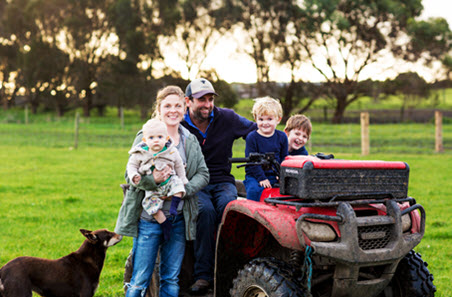Resourceful grazing - using every blade of grass
17 May 2018

Island life has its perks, but it’s not all fishing and surfing for Chris Macqueen, who’s building a simple yet productive beef business on Flinders Island.
The third-generation islander’s family property, 'Skyhaven', is just one of 40 farms on the tiny island north-east of Tasmania.
Although Chris has purchased 300ha since 2012, land on the island is tightly held – so he focuses on lifting productivity.
For the past three years, on an average 875ha (reflecting land purchases), the Macqueens achieved an average dry sheep equivalent (DSE) of 16,133 for the entire property and a mid-winter stocking rate of 14 DSE/ha. The business generated $903/ha of income, $379/ha net profit and produced 357kg of beef/ha (or 57.6kg/ha/100mm rain).
Despite high production potential due to a moderate climate and reliable rainfall, a recent run of springs with lower rainfall has put pressure on the highly-stocked property, so the Macqueens have established simple principles to overcome seasonal challenges.
1. Be ready to de-stock
Stock are managed so they’re always in a saleable condition, to avoid price penalties if a quick sale is required.
“We join cows for six weeks and heifers for four weeks to achieve a tighter spring calving,” Chris said.
“This allows us to wean early if required to take pressure off breeders.
Cows are pregnancy tested six to seven weeks after joining, so dry mature breeders can be sold early to relieve grazing pressure.
2. Make every blade count
After weaning, the mob is split into calves, older cows and younger breeders and rotationally grazed to aid pasture utilisation. Rotations are set to leaf emergence rate, usually 70–80 days in winter and 25–30 days in spring.
Chris has participated in MLA’s More Beef from Pastures and Macquarie Franklin’s Pasture Principles programs, and is part of a benchmarking group led by Holmes and Sackett. He draws on the advice of his stock agent Scott Woods and agronomist Richard Mollineaux, and rates his peers a valuable resource.
“One thing locals have taught me is to push stocking rates to utilise every blade of grass," he said.
Chris prefers to fertilise with nitrogen for productive pastures rather than feed out fodder.
“It’s expensive to cut, store and feed hay to up to 2,750 head (breeders, calves and young cattle) through a dry spring. We sell rather than feed, to free up the best pastures for young cattle," he said.
"We also put back what we take out of our pastures to keep soil fertility up.”
Annual soil tests identify deficiencies and, based on the results, up to 22 units of phosphorus/ha are applied annually.
3. Match-making
“It’s about knowing what enterprise and what animals will meet your targets in your environment. For us, it’s medium-framed cattle that are easy going, productive and adaptable to the seasons," he said.
Chris sources sires for carcase traits and growth rates so steers can reach 450kg by December for the Tasmanian feedlot market.
“We also match pastures to our soil and climate – cocksfoot and lucerne on sandy areas and ryegrass on heavier soils.”
4. Forward planning
Chris uses regular feed budgets to assess when stocking rates need to be lightened.
The biggest logistical challenge of grazing on the island is organisation. It costs $40/head to send cattle on the eight-hour boat trip to Tasmania; boats need to be booked in advance and shipping shuts down over Christmas.
“You can’t ship cattle off-island or bring in fodder quickly when you’re running such large herds. It requires military organisation and speedy decision making," Chris said.
5. Building a sustainable business
These strategies helped Chris to scale-up the business with recent land acquisitions, but he’s always looking ahead.
He meets with an accountant quarterly to monitor their budget, and runs regular models to test the sustainability of the business against scenarios such as increased interest rates or depressed markets.
“Our capital spending is a bit high at the moment, but we’re taking advantage of good interest rates to improve fences and pastures so we can get the farm set up for future sustainability," Chris said.
More information:
Chris Macqueen
Email Chris Macqueen
Chris was a speaker at the 2017 Tasmanian Red Meat Updates. Find out what is on the program for this year's event, to be held 27 July 2018, at redmeatupdates.com


